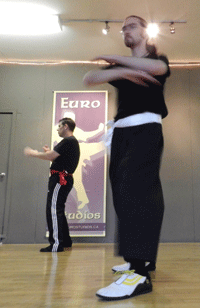Wing Chun has many different origins, depending on who is asked. Several qualities are  common throughout the renditions, however.
common throughout the renditions, however.
-
The Wing Chun System evolved from Shaolin teachings.
-
Wing Chun (aka Ving Tsun) is the name of the female martial artist who made this style famous.
-
Wing Chun has been a popular style of martial arts in Fatshan, Guangdong, China.
-
Grand Master Ip Man (aka Yip Man) brought the most popular Wing Chun style practiced today to Hong Kong.
Four hundred years ago in China, there lived a small family in a village governed by the town of Fatshan. Not wealthy, they managed to make a decent living making and selling bean curd. Their family name was Yim.
The daughter of the family was named Wing Chun. At the age of seven, she was sent by her father to learn Kung Fu at the Shaolin Temple. At the Temple, Wing Chun became the student of a nun by the name of Ng Mui.
A beautiful young woman, Wing Chun began to attract a lot of attention from the young men in her village. Among the many admirers was a warlord, whose advances Wing Chun resisted. In a rage, the warlord caused trouble for the Yim family, provoking a fight with Wing Chun’s father. Not himself trained in Kung Fu, Wing Chun’s father was seriously injured, as was Wing Chun when she interceded.
Shocked that her training had been defeated, Wing Chun realized that it had been her opponent’s strength as well as skill that had defeated her. Resigned, she knew that she would have to re-think her method of Kung Fu. This problem kept her in a long state of meditation.
During this reflection period, she came across a snake and a crane fighting in the fields. Fascinated, she realized that she had found the answer to her problem. She realized that focusing power with maximum speed could defeat an opponent regardless of his power or size.
Keeping the fight she had witnessed in mind, Wing Chun set about refining and modifying the techniques she had been taught. With her confidence rekindled, she sought out the warlord and soundly defeated him. After this, Wing Chun organized her new method into a series of forms: Siu Nim Tau (aka Sil Lim Tao) (“little idea”), Chum Kiu (“searching the bridge”), Biu Chee (“shooting fingers”) and a series of techniques performed on the wooden dummy (Mook Yan Jong). Henceforth, followers call this system “Wing Chun” in memory of the founder.
